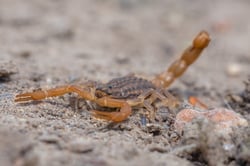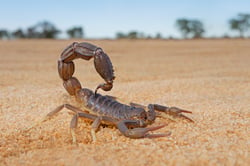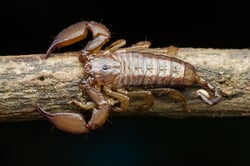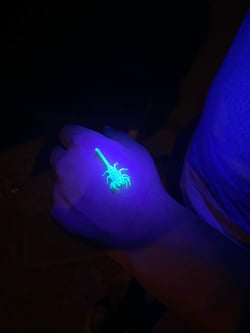Scorpions are among the most feared pests we help our homeowners with. It’s actually a much more commonly encountered pest than you may think! Especially for those living in scorpion-free states, it might be hard to grasp just how widespread scorpions are in the United States. There are around 90 species of scorpions in the US alone, and they don’t all reside in one state or even a few states. In fact, it’s estimated that nearly a third of the states in the US have scorpions!

What are scorpions?
Scorpions are actually predatory arachnids, the same class that contains a variety of spider species. Scorpions are part of the Scorpiones order which is an order made up exclusively of about 2,500 species of scorpions. With eight agile legs, two grasping pincers, and a narrow segmented tail with a defining stinger at the tip, scorpions are some of the more recognizable insects. Scorpions have had 435 million years to evolve into the creatures we know today. Primarily desert-dwellers, scorpions have since adapted to living in a variety of different environments and can be found on every continent with the exception of Antarctica.
As predators, scorpions prey mostly on insects and invertebrates, though some species hunt vertebrates as well. Their strong pincers are used to restrain prey, while their stinger is used to incapacitate and kill said prey. The venom in a scorpion's sting is useful not only for offense but also defense. Scorpions may use their pincers and stinger to ward off predators and prevent their own fate as prey. Still yet, a scorpion’s pincers are also used in mating as male and female scorpions join pincers in a reproductive “dance.” Female scorpions give birth to live young who reside on her back until their exoskeletons harden enough to live independently and safely.
Despite the scorpion’s infamous reputation, very few have venom capable of killing a human. Only about 1% of the scorpion population can effectively kill a person. That said, many can cause significant pain at the point of stinging, and some can cause some health complications as a result, though rarely death.

Where in the United States do scorpions live?
Due to the scorpion’s adaptive nature, scorpions can be found in a variety of environments. Though scorpions are xerocoles, meaning they primarily live in deserts, they can be found in nearly any terrestrial habitat including caves, high-elevation mountains, and even tidal zones. Scorpions can inhabit a multitude of microhabitats as ground-dwellers, tree-dwellers, sand-dwellers, or rock-dwellers. With this knowledge, it becomes more understandable how scorpions can live in a number of different states within the US.
Unsurprisingly, some states have a higher concentration of scorpions than others. States like Arizona, California, New Mexico, Nevada, and Texas are known for their large populations of scorpions due to their largely desert-like environment and climates. Venomous scorpions can also be found, however, in Arkansas, Colorado, Illinois, Kansas, Louisiana, Nebraska, Oklahoma, Tennessee, and Utah. Scorpions have also been identified in Mississippi, Virginia, Florida, and Iowa, as well. Still yet, there have been rare but confirmed sightings of scorpions in Washington, Oregon, North Dakota, South Dakota, and Wyoming!
While there are certainly scorpion hotspots in the United States, the footprint of scorpions is much larger and more widespread than commonly known.

What kind of scorpions live in the United States?
Having established where scorpions live within the US, it’s now key to understand what species you can expect to encounter when visiting or living in scorpion territory.
Psuedoscorpion
As its name would suggest, pseudoscorpions are not scorpions at all but rather a harmless imitator. These insects look very similar to a scorpion with eight legs and pincers, but they do not have a stinger and therefore do not have a venomous sting. They do contain a small amount of venom in their pincers to incapacitate prey; however, it is not nearly strong enough to affect humans. Pseudoscorpions are extremely small and typically reddish in color. Pseudoscorpions are also sometimes referred to as “false scorpions.”
Northern Scorpion
The most cold-tolerant of all scorpions, the Northern Scorpion is generally tan in color with dark brown stripes and large, rounded pincers. These insects prefer sandstone and rocky cliffs, so they are frequently found in high-elevation areas. Their venom-packed stinger is powerful enough to subdue prey but relatively mild to humans. The Northern Scorpion’s sting has been compared to that of a hornet’s sting for most adult humans; however, it can cause localized numbness for a short period of time.
Striped Bark Scorpion
Striped Bark Scorpions can be found in a variety of environments including deserts, forests, and grasslands. Yellowish to light tan in color with two black bands on their abdomens, these scorpions are experts in camouflage for both hunting and hiding purposes. Because of this, Striped Bark Scorpions often sting humans as a result of being unintentionally stepped on or sat on. While their venom is almost never deadly, their sting is very painful and can cause significant swelling.
Southern Unstriped Scorpion
These scorpions sometimes referred to as the Southern Devil Scorpion, are reddish-brown in color with a thick tail and large stinger. Southern Unstriped Scorpions prefer humid climates and can be found in leaf piles or wood stacks, but also venture indoors in crawl spaces or cellars. They occasionally will also hide in shoes, which is the main cause of human stings. Southern Unstriped Scorpion venom is rarely lethal but painful and can cause tenderness, swelling, and redness.
Giant Whipscorpion
Solid black in color, Giant Whipscorpions have long, thin, whip-like tails, claw-like pincers, and antenna-like front legs. Though referred to as a scorpion, Giant Whipscorpions lack venom-filled stingers and are not a threat to humans. They reside in forests and woodlands, hunting a variety of small creatures including termites, slugs, worms, cockroaches, and even other arachnids. Despite lacking a stinger, they can spray a powerful acid that is best used for defensive purposes.
Lesser Stripe-tail Scorpion
Smaller scorpions that are either yellow or brown in color, the Lesser Stripe-tail Scorpion is known for living in localized areas of grasslands, deserts, or mountains. Like all scorpions, they remain hidden during the day as nocturnal insects and emerge at night to hunt. The Lesser Stripe-tail Scorpion's sting is not only potent enough to kill its prey, but also delivers an excruciating sting to humans. Though incredibly painful, the sting typically does not result in severe side effects.
Arizona Bark Scorpion
Arizona Bark Scorpions are yellowish-tan in color and have a distinctively thin, curled tail and large pincers. Commonly found in logs, these scorpions are also known to make their way indoors and hide in drawers, dark cabinets, tubs, barns, attics, or other structures. They are also great climbers and enjoy hanging upside down. The Arizona Bark Scorpion is the most venomous scorpion in the United States. While their sting is typically no more painful than that of a wasp’s, some individuals experience severe allergic reactions to the venom. If you experience difficulty breathing or severe cramping following a sting, seek medical attention immediately.
Giant Hairy Desert Scorpion
As its name suggests, these scorpions are truly large and hairy with crab-like claws and thick, hairy tails. They are the largest scorpion in all of the United States. Found in the rocky deserts of the Southwestern US, these large scorpions are known for taking down sizeable prey including lizards, snakes, and other scorpions. Giant Hairy Desert Scorpion stings are similar to a wasp sting, but some experience allergic reactions to their venom. Allergic reactions can sometimes be fatal, so we recommend you seek medical attention expeditiously if stung.
Stripe-tailed Scorpion
Yellowish-tan with brown stripes along their tail ridges, these scorpions are best identified by their tails that are thicker than their pincers. With a preference for a humid environment, Stripe-tailed Scorpions can be found in a variety of habitats from deserts to rocky mountainsides. They have a number of natural predators like bats, snakes, lizards, birds, and centipedes. Luckily, their venomous stingers are great for defense but are rarely dangerous for humans.
What should I do if I have scorpions in my home?
To prevent stinging encounters with scorpions, do not leave shoes, boots, clothing items, or wet towels outdoors where scorpions can hide. Shake towels around the swimming pool and shake all clothing and shoes before putting them on. Wear gloves when working in the yard. Wear shoes outdoors, especially during the evening hours. A portable black light may be used to survey for scorpions in and around the home. Scorpions glow brightly under black light and are therefore easily found and removed.

If you find scorpions in your home, we recommend you do not attempt to remove them yourself, especially if you cannot properly identify them. Arizona Bark Scorpions, in particular, are incredibly dangerous and can cause severe health complications - they should only be handled by a professional. If you encounter a scorpion in your home, call a trusted pest professional immediately for safe removal.
EcoShield pest technicians are experts in the proper removal of all types of scorpions from your home. Our professionals provide a holistic service that focuses not only on the removal of problem pests but the prevention of them as well. Call or fill out the form on this page today for help with any pest problem, including scorpions!